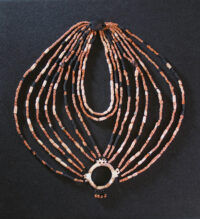 A necklace discovered in the 9,000-year-old grave in Ba`ja, just north of the Red Rose City of Petra in southern Jordan, has been reconstructed from more than 2,580 beads. This is the first time researchers have been able to do an authentic reconstruction of so ancient and so elaborately crafted a piece of jewelry.
A necklace discovered in the 9,000-year-old grave in Ba`ja, just north of the Red Rose City of Petra in southern Jordan, has been reconstructed from more than 2,580 beads. This is the first time researchers have been able to do an authentic reconstruction of so ancient and so elaborately crafted a piece of jewelry.
The necklace was found in 2018 in the richly furnished grave of a female child on her left side in crouch position. Dubbed by archaeologists Jamila of Ba`ja, she was between eight and ten years old when she died. A lump of red pigment was found between her legs and chest, and the outer surface of all of her bones were stained red. The lump of pigment was not the source, nor was any pigment applied directly to her bones. It seems either her skin or her clothes were stained red and when they decomposed, the stain colored her bones.
The beads from a multi-string necklace connected to a central mother-of-pearl ring spacer were found in the chest, neck and left shoulder. Most of the ca. 2,600 beads were small ring discs made of red limestone, with a few barrel-shaped and cylindrical beads of the same material. The red-dominant bead strands are interspersed with white cylindrical beads made of fossilized clam shell, five blue disc beads and two black hematite spherical beads. A larger oval double-holed hematite bead was probably the closing clasp.
The cist grave is also exceptionally rare. It consists of more than 80 sandstone slabs and fragments, with three large slabs as the main structural elements — two upright on the sides, one on top of them covering the chamber– and dozens of deliberately smashed oval slabs stacked in three layers above it.
 The child’s special treatment in death strongly suggests that she was assigned a high social status from a young age, which suggests the existence of hierarchical societal structures in Neolithic Ba`ja otherwise unseen in the relatively uniform funerary architecture of the site. Because the elaborate construction and rich grave goods are so archaeologically significant, archaeologists carefully documented the structure and contents of the grave in situ, then recovered it all piece by piece for study and reconstruction at the Old Petra Museum.
The child’s special treatment in death strongly suggests that she was assigned a high social status from a young age, which suggests the existence of hierarchical societal structures in Neolithic Ba`ja otherwise unseen in the relatively uniform funerary architecture of the site. Because the elaborate construction and rich grave goods are so archaeologically significant, archaeologists carefully documented the structure and contents of the grave in situ, then recovered it all piece by piece for study and reconstruction at the Old Petra Museum.
An international team of researchers collaborating as part of the CARE (Cultural Heritage, Archaeological Research, Restoration and Education) project assessed and conserved the beads and worked to reconstruct the cist tomb itself in the museum. Now that the reconstruction is complete, the necklace has gone on display at the Petra Museum.
A very good article enjoyed
Since the beads are primarily limestone I have to wonder if the small, discoid beads might be disarticulated crinoid stem fragments that have weathered out of an outcrop. They would have to be drilled to turn them into beads but it is a possibility if the local geology is correct.
Her parents must have loved that little girl!
Agree for the way the tomb was so preciously detailed and hidden away for such preservation.